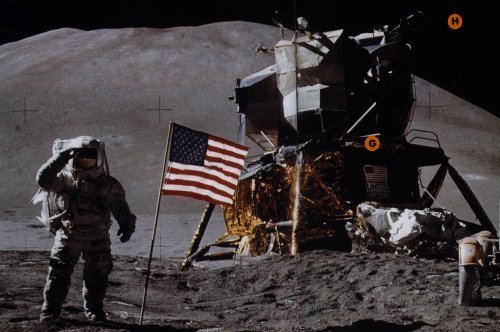
NASA: AS15-88-11864. ANNOTATIONS ADDED BY UNKNOWN
PARTY.
|
 Note H: There are no
stars visible in the sky. Note H: There are no
stars visible in the sky.
See here for a general discussion on the
visibility of stars in lunar photography.
 Note G: You can plainly
see the United States flag on the shaded side of the lunar
module. This could not be a lunar shot because on the moon if
something is in a shadow you cannot see it. The reason we can
on earth is because the earth has air molecules that take light and
bend it, spreading it around objects. Light reflects off air
molecules and lights up the dark sides of objects. However, on the
moon there is no prism of atmosphere to diffuse or bend light so the
sky is totally black. Note G: You can plainly
see the United States flag on the shaded side of the lunar
module. This could not be a lunar shot because on the moon if
something is in a shadow you cannot see it. The reason we can
on earth is because the earth has air molecules that take light and
bend it, spreading it around objects. Light reflects off air
molecules and lights up the dark sides of objects. However, on the
moon there is no prism of atmosphere to diffuse or bend light so the
sky is totally black.
The conspiracist's discussion of atmospheric diffusion is accurate
enough. You would expect no atmospheric diffusion in the absence of
an atmosphere. However, the conspiracist is naive in assuming that
atmospheric diffusion is the only source of indirect light on the
lunar surface.
Conspiracists often note that the moon reflects enough light to
the earth to be able to read a newspaper at night. Yet they ignore
the light-reflecting properties of the lunar surface when talking
about light and dark in photographs.
Imagine standing on the lunar surface in the shade of the lunar
module, as Neil Armstrong was when he first stepped off the ladder.
The sun is not shining directly on you, nor on anything immediately
around you. But if you turn around and look away from the lunar
module, you're likely to see a broad expanse of brightly lit lunar
surface beyond the lunar module shadow. And if you weren't wearing
your protective visor, the glare would hurt your eyes.
The point is that a lot of light rays are heading your way, not
diffused by the atmosphere but bounced off the lunar surface. When
light strikes the lunar surface it bounces off it in all directions.
Some goes back out into space, but some bounces off at angles such to
illuminate objects in shadow. Neil Armstrong reported he had no
difficulty seeing in shadow, but when he went out into the light and
then came back to the shadow, his eyes took several minutes to adjust.
You can see the equipment tray lowered underneath the United
States emblem on the lunar module. Its white insulation glares
very brightly in the sun, probably brightly enough to illuminate the
white emblem.
Recall also that photography is not
always as intuitive as natural eyesight when it comes to lights and
darks. Thus the emblem may be hard to see with the eye, but it's
visible enough to the camera.


| 












